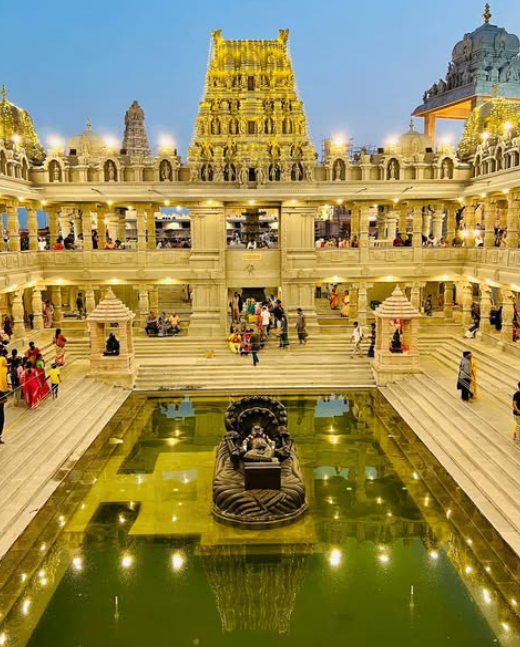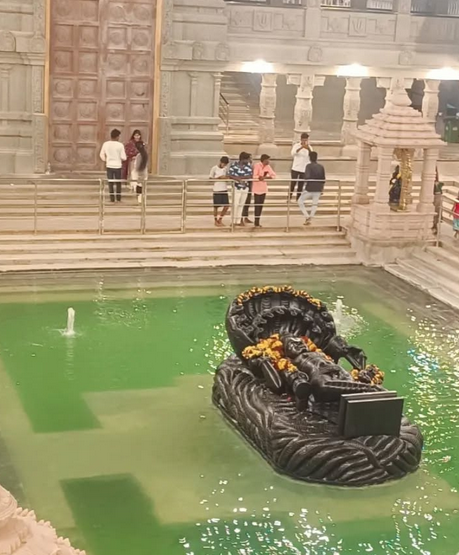
Discover the tranquil and spiritually enriching Swarnagiri Temple in Hyderabad. Learn about its rich history, divine significance, mesmerizing architecture, rituals, and why it should be on every devotee’s list.
Introduction
Hyderabad, the city known for its rich history, vibrant culture, and modern amenities, is home to some of the most magnificent temples in India. Among these sacred shrines, Swarnagiri Temple stands as a beacon of devotion, serenity, and divine connection. Located in the Yadadri district, approximately 47 kilometers from the heart of Hyderabad, Swarnagiri Temple offers not just a place of worship, but a spiritual haven for those seeking peace, tranquility, and a deeper connection with the divine.
In this blog, we will take you on a journey through the history, significance, and architectural wonders of Swarnagiri Temple. We will also explore the various rituals and practices that make this temple a unique destination for devotees and spiritual seekers alike.
A Glimpse into the History of Swarnagiri Temple
The Swarnagiri Temple is a revered Hindu temple dedicated to Lord Venkateswara, an incarnation of Lord Vishnu. This temple is located atop the Swarnagiri Hill, giving it the name “Swarnagiri,” which translates to “Golden Hill.” The hill’s name symbolizes spiritual prosperity and enlightenment, as it is believed that the temple brings divine blessings and success to its devotees.
The origins of Swarnagiri Temple date back to several centuries ago, although it has undergone significant renovations and expansions in recent years. The temple is considered an important pilgrimage site, attracting devotees from all over India and beyond. It is particularly famous for its unique blend of architectural styles, which include elements from the Pallava, Vijayanagara, and Chola dynasties. These influences combine to create a temple complex that is both grand and serene, with every stone and sculpture telling a story of devotion and divine grace.
One of the temple’s most distinguishing features is its association with Lord Venkateswara, also known as Balaji, who is the presiding deity. Lord Venkateswara is considered a protector and provider, and his blessings are sought for health, wealth, prosperity, and spiritual well-being. Devotees believe that visiting this temple brings them closer to Lord Venkateswara’s grace, allowing them to receive his divine blessings.
Architectural Marvel: The Splendor of Swarnagiri Temple

Swarnagiri Temple’s architectural design is a magnificent fusion of traditional South Indian temple architecture with modern influences, making it a visual and spiritual marvel. The temple’s grandeur is reflected in its towering Shikhara (spire) that reaches into the heavens, symbolizing the connection between the divine and earthly realms. The temple is constructed with intricate carvings and sculptures, each depicting scenes from Hindu mythology and the lives of the deities.
The Main Sanctum
The central sanctum houses the idol of Lord Venkateswara, which is the focal point of worship. The idol is adorned with gold and precious gems, adding to its divine radiance. The aura around the sanctum is peaceful and filled with spiritual energy, making it a perfect place for meditation and prayer. The idol of Lord Venkateswara is known for its serene expression, which inspires a sense of calm and devotion in the hearts of the devotees.
The Entrance and Gopuram
As you approach the temple, the towering Gopuram (gateway tower) greets you with its stunning architectural beauty. The Gopuram is intricately carved with images of gods, goddesses, and mythical creatures, telling stories from Hindu epics. The grandeur of the Gopuram sets the tone for the divine experience awaiting visitors inside the temple.
The temple’s entrance is adorned with beautiful pillars and archways, leading to the main hall where devotees gather for prayers and rituals. The hall is spacious and well-lit, with clean marble floors and detailed frescoes that depict important mythological events.
The Outer Courtyard
The temple is surrounded by a vast courtyard, which is a peaceful space where visitors can sit and reflect. The lush greenery and well-maintained gardens add to the serenity of the temple. Visitors often spend time here, absorbing the tranquil atmosphere and contemplating the teachings of Lord Venkateswara.
Smaller Shrines and Sub-Temples
Swarnagiri Temple also houses several smaller shrines dedicated to various deities from Hindu mythology. Each shrine is adorned with intricate carvings and sculptures, showcasing the temple’s artistic heritage. These smaller shrines provide devotees with the opportunity to worship other gods and seek their blessings as well.
Spiritual Significance of Swarnagiri Temple
Swarnagiri Temple is not only a place of worship but also a center of spiritual awakening. The temple’s primary deity, Lord Venkateswara, is believed to be a divine protector and provider. Devotees come to the temple seeking blessings for health, prosperity, success, and spiritual enlightenment. The temple’s significance extends beyond mere rituals—it serves as a place where individuals can reconnect with their spiritual selves and find guidance in their lives.
The Blessings of Lord Venkateswara
Lord Venkateswara is known for his compassion and willingness to grant the desires of his devotees. The temple is believed to be a place where people can ask for anything—from material wealth to spiritual peace. The deity’s divine grace is said to help remove obstacles, heal ailments, and guide individuals toward a path of righteousness.
The temple is particularly famous for its prayers for prosperity and well-being. Devotees often visit the temple to seek blessings for their careers, businesses, family life, and personal growth. The belief in Lord Venkateswara’s divine power is so strong that many visitors come to the temple in times of hardship, hoping to receive his blessings.
A Place for Spiritual Learning and Growth
Apart from its role as a place of worship, Swarnagiri Temple is also a center for spiritual learning. The temple conducts spiritual discourses and teachings on various aspects of Hindu philosophy. These discourses are delivered by esteemed scholars and spiritual leaders, providing visitors with an opportunity to gain deeper insights into the teachings of Lord Vishnu and the path to enlightenment.
The temple encourages meditation and self-reflection, providing a serene environment for individuals to connect with their higher selves and experience inner peace. The practice of mindfulness is also promoted within the temple, helping devotees achieve a sense of calm and clarity.
The Rituals and Practices at Swarnagiri Temple
The rituals at Swarnagiri Temple are an integral part of its spiritual atmosphere. Every day, the temple follows a schedule of pujas (ritualistic prayers) and ceremonies that are designed to honor Lord Venkateswara and invoke his divine blessings. These rituals are an important part of the temple’s daily operations and provide an opportunity for devotees to participate in the sacred practices.
Morning Prayers and Abhishekam
The day at Swarnagiri Temple begins early, with the first prayers held before dawn. Devotees gather to perform Abhishekam, a ritual in which water, milk, honey, and other offerings are poured over the idol of Lord Venkateswara. This act of reverence is meant to cleanse the idol and invite the deity’s blessings into the lives of those present.
The Evening Aarti
Every evening, the temple holds a grand Aarti in honor of Lord Venkateswara. The temple is illuminated with thousands of oil lamps, creating a mesmerizing sight. Devotees participate in the aarti, singing hymns and chanting mantras in praise of the deity. This ritual is considered one of the most spiritually uplifting experiences at the temple, as it involves the collective energy of all devotees coming together in devotion.
Special Festivals and Celebrations
Swarnagiri Temple celebrates a number of important Hindu festivals throughout the year. Among the most significant is Vaikuntha Ekadashi, a festival that honors Lord Vishnu and his divine consort, Lakshmi. This festival is celebrated with grand processions, devotional songs, and special prayers, drawing thousands of visitors to the temple.
Other festivals such as Sri Venkateswara Jayanti (the birth anniversary of Lord Venkateswara), Dussehra, and Diwali are also celebrated with great enthusiasm. These festivals bring an extra layer of vibrancy to the temple, as devotees participate in various cultural and spiritual activities.
Why You Should Visit Swarnagiri Temple
A Sacred Place for Devotees
For devotees of Lord Vishnu and Lord Venkateswara, Swarnagiri Temple is an essential pilgrimage destination. The temple offers an environment of peace and devotion, where visitors can experience the presence of the divine and seek blessings for their well-being.
Breathtaking Views and Serenity
The temple’s location atop the Swarnagiri Hill offers breathtaking views of the surrounding landscape. The natural beauty of the area, combined with the temple’s peaceful ambiance, makes it a perfect place to meditate, reflect, and connect with nature. The journey to the temple itself, surrounded by lush greenery and rolling hills, is a spiritually uplifting experience.
A Rich Cultural Experience
Swarnagiri Temple is a cultural treasure trove. With its architectural grandeur, artistic sculptures, and spiritual significance, it provides visitors with a unique opportunity to experience the rich cultural heritage of South India. The temple’s history and rituals reflect the deep-rooted traditions of Hinduism, offering a glimpse into the spiritual practices that have shaped the region for centuries.
Conclusion
Swarnagiri Temple is not just a place of worship but a sanctuary for the soul. With its divine blessings, spiritual practices, and architectural splendor, it offers a holistic experience that nurtures the body, mind, and spirit. Whether you are seeking divine intervention, cultural exploration, or simply a peaceful retreat, Swarnagiri Temple is a destination that should be on your list.
Take a trip to this sacred hill and experience the divine presence of Lord Venkateswara. Let the temple’s peaceful ambiance guide you on your spiritual journey, and may you return with a heart full of grace, peace, and divine blessings.
FAQs
- What is the best time to visit Swarnagiri Temple? The temple is open throughout the year, but the best time to visit is during the early morning or evening, especially during festivals.
- Is there any dress code for visitors? While there is no strict dress code, it is recommended to wear modest clothing, covering the shoulders and legs.
- Are there accommodations available near the temple? Yes, there are accommodations and guesthouses available near the temple for visitors who wish to stay longer.
- What are the major festivals celebrated at Swarnagiri Temple? The temple celebrates important festivals such as Vaikuntha Ekadashi, Sri Venkateswara Jayanti, Dussehra, and Diwali.
- Can I participate in the rituals at the temple? Yes, visitors are encouraged to participate in the daily prayers and rituals, especially the morning Abhishekam and evening Aarti.
